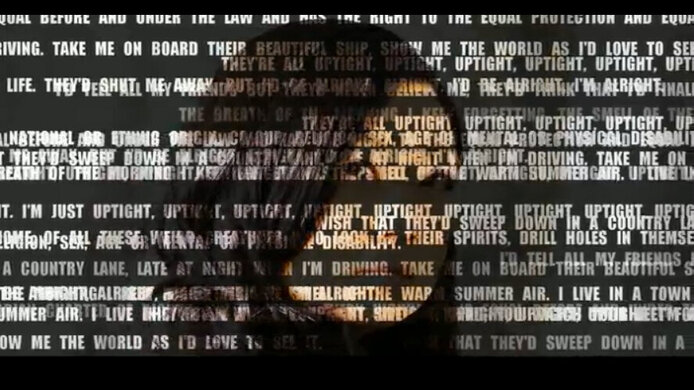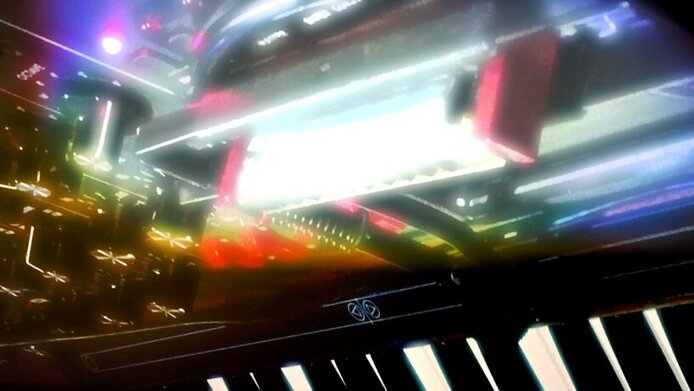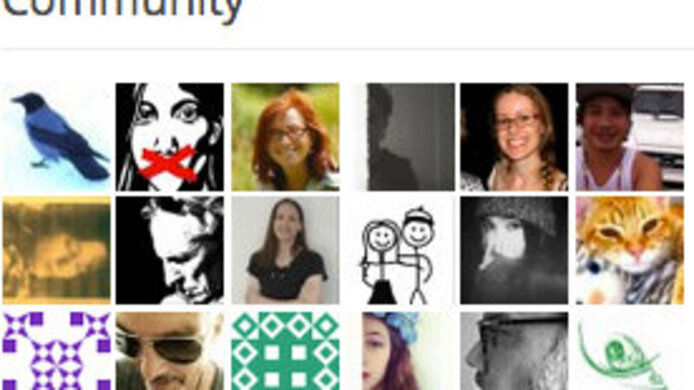Social media in the service of art

Gloria is a young Canadian who works in the human rights sphere. In her leisure time, Gloria likes to make music and plays in an indie band. In the social media she discovered the what-if blog. Since that time, Gloria has shared thoughts about her Korean roots and her identity on that blog, composed music and personalised the multimedia installation Read me, which she now wants to present at a gallery in Canada. The installation is part of an arts-based research project funded by the Austrian Science Fund FWF. [caption id="attachment_3215" align="alignnone" width="1062"] Ken Ficara is a US web manager. He was voted the winner of the #WhatIfDrone contest for his music contribution.[/caption]
Ken Ficara is a US web manager. He was voted the winner of the #WhatIfDrone contest for his music contribution.[/caption]
High art – inspiring a young audience
With the help of TransCoding, the project manager Barbara Lüneburg from the University of Music and the Performing Arts in Graz wants to encourage young adults between 20 and 35 to take an interest in art and, what is more, let them participate in the art process. “This age group is more often attuned to popular culture and therefore hard to reach for contemporary and experimental art”, explains Lüneburg. The trained violinist has made a name for herself as someone who likes to move freely between genres and art forms and as a specialist of new music. For a long time she has also been engaged in research on the topics of “concert aura” and “collaboration”. In this context, Lüneburg explores how artists can engage with the audience and how (young) people can be motivated to address issues that affect them by means of art. [caption id="attachment_3217" align="alignright" width="276"] A blog as exchange hub between artists and people interested in art. Within one year, the network grew to include 800 individuals.[/caption]
A blog as exchange hub between artists and people interested in art. Within one year, the network grew to include 800 individuals.[/caption]
Social media as a pivotal point
In order to reach her target audience, Lüneburg chose “identity” as the artistic theme of the FWF project. “A topic that concerns everyone”, notes the musician. Hence, the question she puts to the “community” concerns the nature of identity and what it means to them. “In this way, the project enables a young audience to participate both in an art process and societal discourse across socio-cultural boundaries”, says Barbara Lüneburg. Since February 2014, which saw the start of the project and the ensuing launch of various online platforms, an international network of more than 800 interested individuals, young artists and professionals has emerged. The blog constitutes the central medium for exchanges about music, text contributions and creative processes.
Participation via “art selfies”
The first composition entitled What if we had wings?, based on the art concept of the project leader, was premiered at the European Researchers Night 2015. The piece integrated personal desires and wishes sent in by the members of the network to the blog operators upon a call for entry. Another work of art arising from the project is the above-mentioned installation Read me. Upon request, Lüneburg will personalise it for members of the community as she did with the input from Gloria. “The people get very involved in such a thing, because it creates something that relates to them. And there is no fear or shyness because it is their own thing. – Even if it is transformed into multi-media art.” In Gloria’s version Read me presents texts that the young woman identifies with and relates to. In the background one sees a picture of Gloria, and the music was composed by Lüneburg from Gloria’s material.
Creating cross-links
You, us and the project, Making of and Art we love are further elements of the blog in which the project team lets people have a look behind the scenes of artistic work. – “Things that you wouldn’t ever normally see”, emphasises Lüneburg. The next step in the project is the creating of an offline format in terms of a multi-media solo show for violin, live electronics and video. The aim is to create cross-links between popular and high culture. Altogether it was a multi-layered and time-consuming project, summarised the project head. On the internet one has to build a community step by step, by launching calls for entries, running contests and addressing topics that everyone can relate to. Some good progress has been made, and the network thrives on all four continents, from Europe to India and the Canadian-Arctic archipelago where the young lawyer Gloria is currently working.
Art research
From a scientific perspective, the TransCoding project seeks to offer a change of perspective from the retrospective academic investigation of a work of art to an art project where the participative online and offline network explores the role of the artist and challenges an academic approach. – The aim is to enable more permeability and mutual influence. Lüneburg is convinced that this could also trigger a process of democratisation among artists.
Personal details On 1 October 2015, Barbara Lüneburg was appointed senior scientist at the Artistic Doctoral School at the Graz University of Music and the Performing Arts. Her doctoral thesis investigated the creative potential of performers in contemporary music, and she teaches in the field of new media and arts-based research. As a musician, Lüneburg is an internationally recognised soloist and chamber musician and also directed her own ensemble for contemporary music, ensemble Intégrales. Her repertoire covers a broad range from Bach to New Music and multimedia. The arts-based science project TransCoding will run until 2017.
Links
“what if” blog on participation: http://what-ifblog.net/ Facebook Page: https://www.facebook.com/whatif.participatoryArt SoundCloud: https://soundcloud.com/what-ifblog/ Twitter: https://twitter.com/what_ifblog "what if" on YouTube: http://bit.ly/1j969jb
The FWF’s PEEK programme: http://www.fwf.ac.at/de/forschungsfoerderung/fwf-programme/peek/
> Media Enquiries
[Translate to English:]
Soziale Medien als Ankerpunkt
Um ihr Zielpublikum zu erreichen, hat Lüneburg „Identität“ als künstlerisches Thema für das FWF-Projekt vorgegeben. – „Ein Thema, das jeden betrifft“, so die Musikerin. Die Frage an die „Community“ lautet also, was Identität ist und was es für sie bedeutet. „Das Projekt ermöglicht damit einem jungen Publikum, über sozio-kulturelle Grenzen hinweg, sowohl an einem Kunstprozess als auch an einem gesellschaftlichen Diskurs teilzuhaben“, sagt Barbara Lüneburg. Seit Februar 2014, dem Start des Projekts und dem darauffolgenden Launch diverser Online-Plattformen, hat sich ein internationales Netzwerk von mehr als 800 Interessierten, Nachwuchskünstlern und Professionisten gebildet. Der Blog stellt dabei das zentrale Medium des Austauschs über Musik, Textbeiträge und kreative Prozesse dar.
Partizipation via „Kunst-Selfies“
Die erste Komposition "What if we had wings?", die auf dem künstlerischen Konzept der Projektleiterin basiert, hatte bei der European Researchers Night 2015 Premiere. In die Kunst integriert waren persönliche Wünsche und Visionen, die die Mitglieder des Netzwerks über einen sogenannten "Call for Entry" den Blogbetreiberinnen geschickt hatten. Ein anderes Kunstwerk des Projektes ist die erwähnte Installation "Read me". Lüneburg personalisiert sie auf Wunsch für Community-Mitglieder, so wie sie das mit dem Input von Gloria gemacht hat. „Dabei sind die Leute sehr involviert, denn es entsteht etwas, was sie betrifft. Und es gibt keine Berührungsängste mehr, weil es ihre eigene Sache ist. – Auch wenn es zu multimedialer Kunst verarbeitet wird.“ In Glorias Version zeigt "Read me" Texte, mit denen sich die junge Frau identifiziert und verbunden fühlt. Im Hintergrund ist Glorias Bild zu erkennen, und die Musik hat Lüneburg aus musikalischem Material der Kanadierin komponiert.
Querverbindungen schaffen
„You, us and the project“, „Making of“ und „Art we love“ sind weitere Elemente des Blogs. Hier erlaubt das Projekt-Team unter anderem Einblicke hinter die Kulissen von künstlerischer Arbeit. – „Dinge, die man normalerweise nie sehen würde“, betont Lüneburg. Der nächste Schritt im Projekt ist der Weg zum Offline-Format in Form einer Multimedia-Solo-Show für Violine, Live-Elektronik und Video. Hier sollen Querverbindungen zwischen populärer Kultur und Hochkultur entstehen. Insgesamt sei es ein sehr vielschichtiges und aufwändiges Projekt, erzählt die Leiterin. Auch im Internet gelte es, Schritt für Schritt eine Community aufzubauen. Das gelingt mit Ausschreibungen, Wettbewerben und eben Themen, die alle ansprechen. Die Zwischenbilanz ist erfreulich und das Netzwerk lebt auf allen Kontinenten, von Europa über Indien bis zum kanadisch-arktischen Archipel, wo Gloria, die junge Anwältin, derzeit arbeitet.
Künstlerische Forschung
Aus wissenschaftlicher Sicht will das Projekt „TransCoding“ einen Perspektivenwechsel bieten von der akademisch rückblickenden Untersuchung eines Kunstwerks zu einem Kunstprojekt, in dem das partizipierende On- und Offline-Netzwerk die Rolle des Künstlers/der Künstlerin hinterfragt und akademisches Arbeiten herausfordert. – Mit dem Ziel, mehr Durchlässigkeit und gegenseitige Einflussnahme zu ermöglichen. Dies könne auch einen Demokratisierungsprozess bei den Künstlern anstoßen, ist Lüneburg überzeugt.
Zur Person Barbara Lüneburg ist seit 1. Oktober 2015 Senior Scientist der künstlerischen Doktoratsschule an der Universität für Musik und darstellende Kunst Graz. Sie hat über das kreative Potenzial der Interpreten in der zeitgenössischen Musik promoviert und lehrt im Bereich Neue Medien und künstlerische Forschung. Als Musikerin ist Lüneburg international als Solistin und Kammermusikerin bekannt und leitete unter anderem ihr eigenes Ensemble für zeitgenössische Musik, ensemble Intégrales. Ihr Repertoire reicht von Bach bis zu Neuer Musik und Multimedia. Das wissenschaftlich-künstlerische Projekt „TransCoding“ läuft noch bis 2017.
Links







